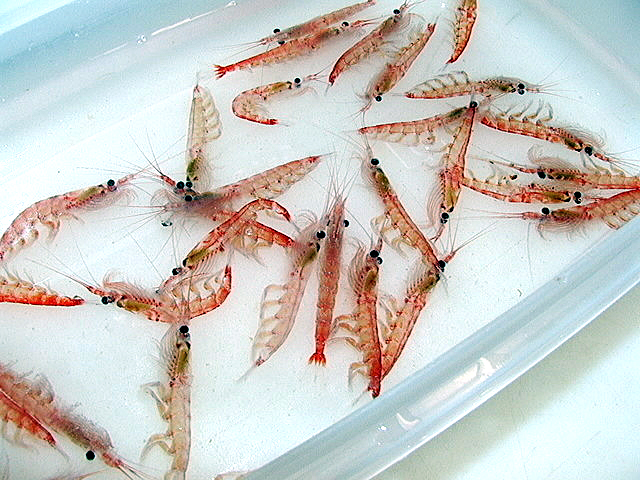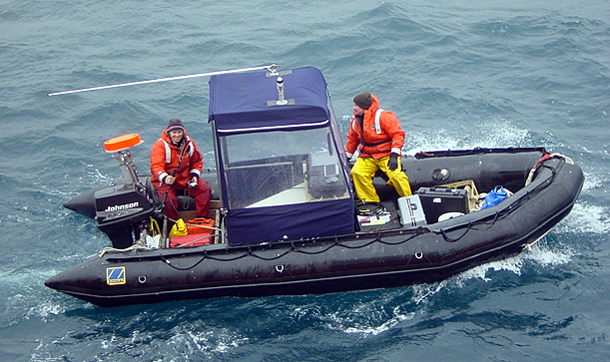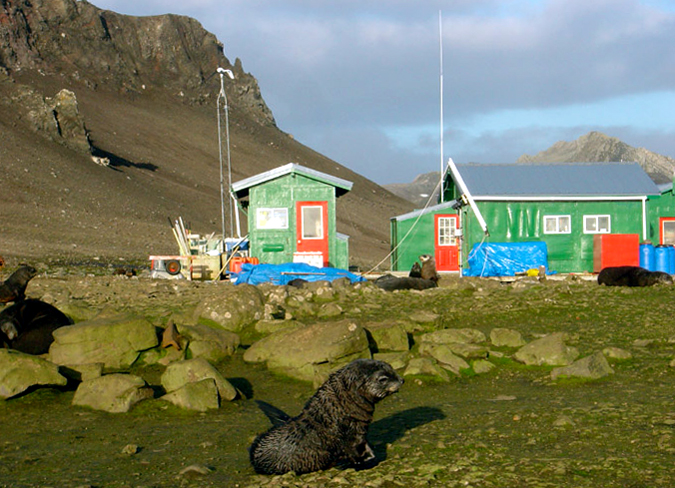Hugging the shoreScientists find high krill density in coastal areas in first multi-year studyPosted September 10, 2010
Seals and penguins that inhabit Livingston Island appear to have a steady food source near to home — though it’s unclear if some of Antarctica’s top predators have to share with the krill fisheries that operate in the region. A recent paper in the July issue of the journal Canadian Journal of Fisheries and Aquatic Sciences reported finding significantly higher, and more stable from year to year, krill biomass density in coastal areas than in deeper, offshore waters. “It’s one of — if not the first — surveys over many years of a near-shore area, and we found very high krill densities there, and that may be important for the ecosystem,” said Joseph Warren Warren and co-principal investigator David Demer Warren explained that the project was an offshoot of work done during a four-ship, multinational krill survey under the auspices of the Convention of the Conservation of Antarctic Marine Living Resources (CCAMLR) Warren then joined Demer beginning in 2002 for five field seasons on Livingston Island to survey the nearby waters for krill, a shrimplike animal that’s a key species in the Antarctic food web. The site was attractive for a couple of reasons. It’s home to top predators like barking fur seals and chinstrap penguins. Also, it’s a base of operations for a long-term study of the mammals by the Antarctic Marine Living Resources (AMLR) program The AMLR program provided both logistical and personnel support for the research. A part of the Antarctic Treaty System “The amount of krill being caught overall is fairly low relative to the total population,” Warren noted, but added, “One of the possible concerns is that if fishermen are catching krill in the same area that the predators are using that resource, then maybe there could be a problem.” Hence determining the amount of krill available in the shallow waters near shore may be important in order to manage the fisheries better. “The amount of krill in the near-shore area appears to be sufficient enough to feed the penguins, the fur seals and the baleen whales that are living in this area,” Warren said. However, it’s unclear at this time how much human competition there may be for those specific resources, he added. Why the high densities near the island? Warren said one working hypothesis involves two submarine canyons that may be a hotspot for life, funneling nutrients to the surface waters to feed phytoplankton, plant cells upon which the krill eat. 
Photo Credit: U.S. AMLR Program
Krill, a crustacean, is a key food resource for many of the whales, seals and sea birds in Antarctica.
Separate studies by the Palmer Long Term Ecological Research (PAL LTER) “If you’re an animal that needs krill, it’s possibly a more stable resource,” Warren noted. The two scientists conducted their surveys every austral summer between 2002 and 2007 except in 2003. A Russian research vessel contracted by NOAA to support the AMLR program dropped them off at a field camp at Cape Shirreff on Livingston Island. NOAA also funds and operates a second field site on nearby King George Island. The National Science Foundation (NSF) “The support from the field camp was great,” Warren said. “Without their assistance, this study couldn’t have been done … And they fed us extremely well. When you’re out in the small boat, having really good food is critical.” Using a 6-meter-long inflatable Zodiac, the researchers ran transects of the near-shore environment using an acoustic echo sounder mounted on the transom of the boat. The instrument is similar to a fish finder in that it sends a sound wave into the water and listens for echoes from objects in the water column. Using multiple frequencies of sound, krill aggregations can be differentiated from other signals, though Warren said they would also lower a video camera into the water to confirm the presence of krill swarms. A scientist and boat driver would spend up to seven or eight hours on the water before they ran out of energy and body heat, Warren said. Weather would also dictate the length of a field day. “We were able to work in pretty big conditions. We worked in seas up to about three or four meters,” Warren said. The researchers plan to publish additional papers based on their data, linking their findings to the work conducted by NOAA scientists at the Cape Shirreff camp studying the ecology of the penguins and seals. However, Warren’s next trip to the Antarctic at the end of this year involves a study comparing krill and another common zooplankton — salps, a critter that resembles a small, barrel-shaped jellyfish. “We’re trying to investigate whether there are some environmental factors that may be related to where you find salps and where you find krill,” Warren explained. The NSF-funded project will take place aboard the research vessel Laurence M. Gould Recent expeditions in the region have found that salps, a filter feeder, may be outcompeting krill in some areas. That could have repercussions in the food web because krill are far more nutritious than salps. On the other hand, new research implies that salp waste material may help remove carbon dioxide from the upper ocean and the atmosphere. NSF-funded research in this article: Joseph Warren, Stony Brook University, Award Nos. 0633939
|



For USAP Participants |
For The Public |
For Researchers and EducatorsContact UsU.S. National Science FoundationOffice of Polar Programs Geosciences Directorate 2415 Eisenhower Avenue, Suite W7100 Alexandria, VA 22314 Sign up for the NSF Office of Polar Programs newsletter and events. Feedback Form |



